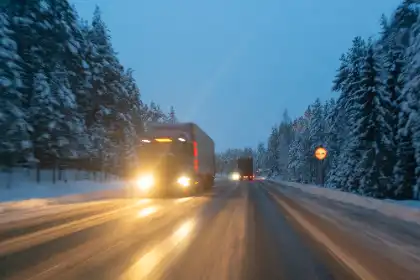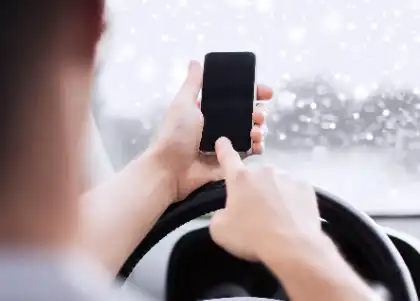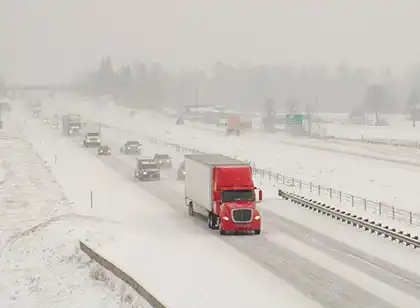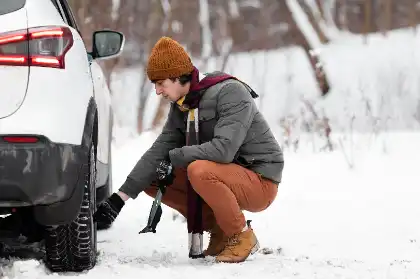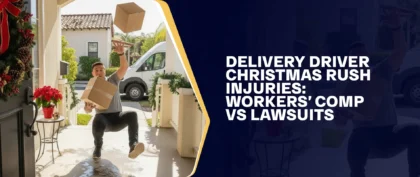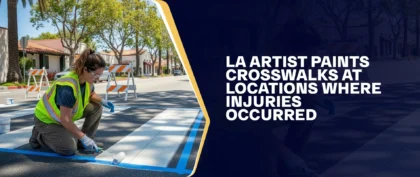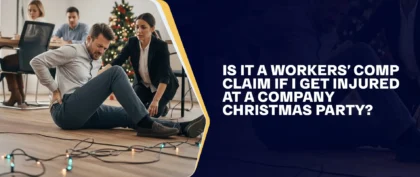Table of Contents
The holiday season is the busiest time of the year and can be pretty overwhelming. People travel to spend quality time with their loved ones and rush to the shopping malls to look for the perfect gifts. Naturally, the number of vehicles we see on the road increases as we get closer to Christmas and the New Year. Sadly, crowded highways, especially during winter weather, can cause driving-related accidents. It’s easy to forget about the heightened risk of personal injury during this festive season. Still, it’s crucial to prioritize holiday driving safety, whether you’re heading home for the holidays or on your way to the mall.
With a higher possibility of traffic-related accidents, how do you stay safe on the road during the holidays? Fortunately, there are several steps you can take to help make your holiday season driving safer. Before getting behind the wheel, take note of this holiday driving safety guide for a happy and safe festive season.
Nevertheless, if you were involved in a collision and are suffering from injuries, our team at Arash Law, a full-service California personal injury law firm, can help. Call (888) 488-1391 to connect with our car accident lawyers who handle complicated motor vehicle cases and advocate for just compensation for victims.
Holiday Driving Safety Tips
During the holiday season, many individuals travel to see their loved ones. Some people even spend long hours driving to be with their family on Thanksgiving and Christmas. Unfortunately, the Thanksgiving, Christmas, and New Year’s Eve holidays are some of the most dangerous times to travel, and understandably so.
Driving on congested highways on regular days puts everyone at risk for car accidents. However, it is even more dangerous during the holidays when the roads are all covered in snow. Winter storms can create difficult driving conditions, and the increased presence of drivers who may have had too many spiked eggnogs at the office party adds to the risk. These factors make driving especially dangerous.
Following the holiday safe driving tips below can help make your travels much safer this season:
Clear Your Car Of Snow And Debris Before Heading Out
Take a walk around your vehicle to ensure it’s ready for driving. Remove all snow and ice from every window to have a clear view. Don’t be the person who only cleans off the driver’s side of the windshield. Aside from that, clear off the roof and trunk to prevent snow from obstructing your rearview window.
Never Drink And Drive
Perhaps one of the most typical safe driving tips for winter you’ve heard too many times is to never drink and drive. Looking at the fatality data for December between 2018 and 2022, 4,759 individuals died in DUI-related accidents. Over a thousand people died in December 2022 due to alcohol-impaired driving crashes. These tragic incidents could have been avoided.
For your safety, avoid driving after you consume alcohol. If you’ve had a drink or two, consider alternative transportation options, such as calling a taxi or asking for help from a friend who can drive you home. You can also book a rideshare service such as Uber or Lyft in advance if you plan to drink at holiday gatherings. In any case, being responsible and making sound choices can help keep you safe.
Drive With Caution
Driving can be risky when there is fog, black ice, slush, or snow on the roads. Keep your undivided attention on the road ahead. Consider these driving adjustments as a further precaution:
- Watch out for slippery areas, especially under bridges, overpasses, and shaded spots.
- Maintain a safe distance from other vehicles, including trucks and buses. Additionally, keep your distance from any snowplows to avoid flying debris and prevent limited visibility from the plowed snow.
- Brake and turn with care. Reckless maneuvers can lead to loss of driving control, which is more dangerous on icy roads. Use your turn signals before making a turn.
- Reduce your speed. According to the California Department of Motor Vehicles (DMV) handbook, drivers should adjust their speed based on what road conditions allow. Here are some examples:
- Wet Roads — Reduce your speed by 5 to 10 mph.
- Road Packed With Snow — Reduce your speed by half.
- Icy Roads — Reduce your speed to no more than 5 mph.
- Slow down as you approach intersections. Unless you’re passing, stick to the right-hand lane.
- Steer smoothly and precisely to prevent skidding. If you start sliding, ease off the gas pedal or brakes. Turn into the skid until you regain traction, then straighten your vehicle.
Follow The Rules Of The Road
Safe driving hinges on your ability to adhere to traffic rules. Local speeding laws are assigned based on specific considerations, like the usual flow of traffic and road conditions in an area. Failing to drive according to the posted speed limit may not only result in hefty fines but also puts people’s lives at risk.
Paying close attention to road signs is also an important responsibility for drivers. These are laid out so drivers are immediately informed about any potential hazards, upcoming turns or exits, and other things on the road that require advanced notification.
Always Have A Full Gas Tank
When driving in unfavorable weather conditions, be cautious, prepare in advance, and ensure you have sufficient fuel. Running out of gas during a snowstorm or heavy rain can leave you stranded in hazardous situations. To avoid this, consider the following tips:
- Keep Your Tank Full — Aim to keep your fuel tank at least half full, especially in winter. This prevents running out of fuel if you’re stuck in traffic or need to take a detour.
- Plan Fuel Stops — Identify gas stations along your route before setting out. Stopping frequently for fuel is better than risking emptying your tank in remote areas.
- Monitor Your Gauge — Pay attention to your fuel levels, especially in slower traffic or areas with limited gas stations.
Fasten Your Seatbelt Before Driving
Make sure that you and your passengers are secure while driving, especially during December, when the weather can be unpredictable. Even a short trip to the nearby store can be dangerous if you encounter black ice. Taking a few seconds to buckle up can save your life.
Research shows that almost half of the people who died in car accidents didn’t wear their seatbelts. Based on estimates from the National Highway Traffic Safety Administration (NHTSA), using a seatbelt can significantly lower the risk of serious injury by 50% and the likelihood of death by 45%.
Lock Your Vehicle At All Times
Many Americans take long driving trips during the holiday season. The excitement you feel can cause you to overlook the most basic safety measures, such as locking your vehicle before you head out or when you need to step out for a moment. Keep your cars locked while traveling, when you stop, and after reaching your destination. Never give strangers access to your car.
Take Regular Breaks During Your Travels
Try to stop every two to three hours. Remember, fatigued driving is among the leading causes of vehicle accidents. Take a moment to step out of the car and stretch your legs. These breaks will keep you more awake and reduce stress. If possible, take turns driving with other licensed passengers.
Avoid Driving At Night
Try to arrive at your destination before sunset, even if it requires waking up at 4 AM. Research indicates that driving at night is riskier, as you may not notice motorcyclists or come across intoxicated drivers.
Driving during the day is generally safer than driving at night. However, on days with poor visibility, especially when the sky is overcast or dark, always use your headlights. Not only will doing this make it easier for you to see the road ahead, but it also allows other drivers to notice you.
Avoid Driving Distractions
In winter, the roads can be dangerous. Even the slightest distraction can lead to car accidents. Stay focused on driving and remain alert. Using a cell phone while driving is illegal, so keep it out of sight. Inform your loved ones and colleagues that you won’t be able to respond to calls or texts until you reach your destination. If you need to call, find a safe spot to pull over and check your messages.
Staying On High Alert When Driving During The Holidays
Here are some hazards to watch out for on your winter holiday drive:
Drunk Drivers
According to MoneyGeek, “winter was the least likely season for DUI-related fatal accidents to occur.” However, based on their analysis of NHTSA data, New Year’s Day (January 1st) is the deadliest day of the year for DUI. If you’re driving and you notice a vehicle that’s moving erratically, there might be a chance that an impaired driver is behind the wheel, so keep a safe distance from it.
Reckless Drivers
Additionally, be cautious of other drivers. As you may already know, not all drivers are skilled, and you may have witnessed some taking risky actions on the road. When combined with unfavorable weather conditions, they can easily cause reckless driving accidents. Therefore, it’s best to stay alert while driving, as other drivers may overtake you at high speeds, encounter icy patches, make sudden maneuvers, or have excessive confidence in their driving abilities or their vehicle’s capability to handle the weather.
Large Vehicles
Be cautious when driving near trucks and buses, particularly on icy or snow-covered roads. It’s hard to see beyond these vehicles. When passing a truck or bus, check first whether you have plenty of space and complete the maneuver quickly and safely. Avoid lingering in their blind spots or driving too closely behind, as you might not have enough time to react if they stop or swerve suddenly.
Motor Vehicle Crashes
Stay alert to your surroundings. Be vigilant for anything that might impact your driving. If you hear sirens or see emergency lights, pull over to the side of the road and let the fire truck, ambulance, or police car pass by. Also, keep an eye on the road ahead in case of a crash. If you spot anything, reduce your speed, as you never know the cause of the initial motor vehicle accident and wouldn’t want to contribute to it. When you pass by, maintain a significant distance to avoid any extra dangers.
Black Ice
Black ice on the road poses a serious risk. Black ice is transparent and blends seamlessly with the asphalt, making it nearly invisible. It forms without bubbles, creating smooth, glossy patches that mimic the appearance of regular pavement.
While difficult to detect, black ice can sometimes be identified in the right lighting. Look for unusually shiny, glossy areas on the road, contrasting with the duller black of the surrounding pavement. If you notice a slick patch ahead, reduce speed and proceed cautiously.
Planning For A Safe Winter Holiday Road Trip
Proper planning for your holiday road trip can save you and your family from unnecessary risks and promote a safer journey. Whether you’re driving to somewhere warm, like California, or venturing out to a snow-covered destination, it’s crucial to be prepared for anything that might come up during your trip.
Here are some ways to plan for your trip and mitigate unexpected issues:
Planning Your Route
Plan your route whenever possible. Try to steer clear of roads with steep inclines or sharp turns, which can make maneuvering difficult, especially when there’s snow and ice. Be mindful of the expected weather, road conditions, and traffic. Before you drive off, check the news or map applications for any road closures and potential dangers. This way, you’ll have an idea of whether you need to take a detour along the way. If you can, stick to the main roads and highways. They might be busier and more crowded, but they are also well-lit, well-maintained, and have more law enforcement and public safety personnel. Avoid unnecessary risks that could lead to getting lost or stranded, especially when traveling alone or with children.
Do not rush to reach your destination. Before you go, familiarize yourself with maps and directions, even if you rely on a GPS. Also, inform others of your route and estimated arrival time.
Bring What You Need
When preparing for a trip, you’ll want to pack the essentials. Remember to pack food, non-alcoholic beverages, blankets, pillows for the passengers, first aid kits, and any necessary medication for yourself and your fellow travelers. If you’re driving somewhere cold, then make sure to bring extra pairs of socks, gloves, coats, scarves, and other items of clothing that will keep you warm and toasty.
If you’re traveling with children, don’t forget to bring suitable games or books for their age. Anticipate that at any given moment, one of your kids will get bored and start making a fuss about the long drive.
Additionally, keep your phone fully charged and, if possible, bring a car charger. Organize your belongings as well. Keep your essentials, such as your wallet, medication, phones, and other smaller yet important items, inside a duffel bag or a backpack. Place the bag in an accessible location inside your vehicle’s cabin. This way, you can easily take the important things with you in case of an emergency.
Driving Safely After Your Holiday Celebration
People gather and have a good time with their loved ones, often enjoying beer or wine to celebrate special occasions. However, people may not recognize when they’ve had too much to drink. Unfortunately, they might overestimate their ability to drive after drinking a few shots. Ultimately, this festive drinking may lead to more DUI car accidents.
Even though we’re aware of the dangers of drinking and driving, thinking that “I only had a few” can lead to a car crash. It’s important to remember that it’s illegal not only to drive while drunk but also to drive while slightly intoxicated. Even a small amount of alcohol in your system can affect your vision, make you drowsy, or slow down your reaction time. If you’re in this situation, it would be best to stay put and allow a few more hours to rest before you hit the road. Remind your friends and family that no matter how capable they feel after drinking, they should never get behind the wheel.
Holiday Drinking And Safety Tips For Hosts
If you’re organizing a holiday party, include safe transportation options in your planning. While great food, drinks, decorations, and music can make for a memorable event, a responsible host will ensure their guests can return home safely and talk about the party for years.
To reduce the risk of your guests getting involved in a DUI accident, here’s what you can do:
- Gather car keys from your guests upon their arrival.
- Provide plenty of water and non-alcoholic beverages to help prevent guests from overindulging in alcohol.
- Arrange for a designated driver (or drivers) to drive guests home.
- Consider renting a “party van” with a driver or a rideshare service to ensure safe transportation.
- Prepare a spare room or sofa for guests who are unable to drive home.
- Book a rideshare service to ensure your guests arrive home safely.
During the holidays, especially New Year’s Eve, the demand for rideshare services and taxis is very high. Although they are usually a great way to get everyone home safely after drinking, they might not be a practical option for you and your guests. In such cases, a private transportation solution could be the best choice.
Safety Driving Tips For Guests This Holiday Season
While holiday parties are a great time to cut loose and enjoy the company of your dearest friends, it’s essential to do so responsibly. If you know that you’re going to drink or that there’s a possibility you might drink, then you owe it to yourself to make sure you have a way to get home safely. Before you go out, consider the following:
- Make sure to have someone (who is sober) watch over you and your group.
- Request a responsible friend or family member to be your designated driver (and show your appreciation with a lovely present!).
- Plan and arrange transportation in advance using a service like Uber or Lyft.
- If the party or venue is far from your home, consider booking a hotel room nearby for convenience.
Once again, rideshare services and taxi companies are great options for a secure ride home. However, there is usually a high demand for these services during the holidays. So, it’s better to plan and make arrangements to ensure a pleasant evening and create lasting holiday memories.
Keeping Children Safe During Holiday Travel
When going on holiday road trips, the safety and well-being of your children should also be at the top of your priority list.
Helping Kids Stay Warm During Travel
When traveling with kids, make sure that they’re as comfortable as possible. Bring some bulky sweaters, coats, and blankets on your trip. Before you leave for your trip, dress your kids in temperature-appropriate clothing. However, before strapping your child into their car seat, remove some of the layers to ensure the harness fits them properly. Instead, you can drape a warm blanket over the straps for warmth.
Using Seatbelts And Car Seats Properly

Check In With Them From Time To Time
If you can, accompany your child in the back seat of your car. After long hours on the road, children may get fussy. With you (or an older child) sitting in the back with the younger kids, you’ll be able to address issues that might arise during your trip, including car sickness, the need to use the bathroom, and boredom.
Teaching Your Children How To Be Safe
Children should always be accompanied when going to or leaving the car. Never leave them unattended. Teach children about their complete name, address, and telephone number so they can provide it to police officers or mall security if needed. Additionally, teach children to inform you immediately if they feel uncomfortable or threatened by a stranger.
Tips For Traveling With Pets On Your Winter Holiday
Over 60% of American families own pets, and in recent years, more people are taking their pets on vacation. To support your pet’s comfort and safety during long trips, you can follow these simple tips:
- Prepare the Essentials — Check travel requirements in advance and pack clean water, food, bowls, waste bags, wipes, travel documents, vaccination cards, and any medication. Consider microchipping your pet.
- Keep Pets Secure — Use carriers, crates, or pet seat belts to keep your pet safe and prevent distractions. Bring a crate that is spacious and pack familiar items, such as a blanket or toys. Aside from providing a more comfortable trip for everyone, it also maintains the safety of your pets and other people in case of sudden stops or traffic accidents.
- Take Breaks — Stop every 2-4 hours for food, water, and breaks. Pack clean-up items and follow your pet’s usual schedule. Line carriers with urine pads.
- Never Leave Pets Alone in a Car — Never leave pets (or children) alone in a parked vehicle, as they are vulnerable to extreme temperatures.
Tips For Traveling With The Elderly During The Holidays
Fancy taking older family members on a nice holiday? Here are some things to consider before you hit the open road.
- Know Their Health Needs — Discuss any specific health considerations and research medical facilities along the route to your destination. Keep a copy of their medical records, list of prescriptions, and emergency contact information easily accessible. Additionally, plan for regular breaks to allow them to stretch and rest, prioritizing their comfort and safety throughout the trip.
- Keep Track of Their Medication Intake — People use the holiday season to forget about their worries in life; just don’t forget to remind your elderly travel companions about taking their medication on time! If it helps, organize the over-the-counter and prescription medications inside a pill organizer or another easily accessible container. Consider gifting them wearable health technology, like a smartwatch, that tracks vital signs and sends reminders about taking their medicine.
- Think Ahead for Comfort — Your elderly loved one’s condition might make vehicle rides physically uncomfortable for them. So, it’s up to you to make a couple of adjustments to attend to their needs. Look for supportive cushions for cars or car seats that are intended for older adults. You can also look into seat lifts and other products that make getting in and out of a car easier for your older companion.
Holiday Safety Tips For Pedestrians
As the holidays get closer, people will be out and about, enjoying festive activities or shopping for Christmas. If you’re wondering how to stay safe on the road and avoid pedestrian accidents during the holiday season, here’s how:
- Follow the laws and avoid walking on highways or restricted zones. Use sidewalks whenever possible, and only cross roads at designated crossings.
- When there are no sidewalks, walk on the side of the road facing the traffic. Additionally, try to stay on the shoulder of the road as much as possible.
- Wear bright-colored clothes so drivers can easily see you. Furthermore, wear clothes that reflect light and carry a flashlight when you walk at night.
- Always be mindful of your surroundings and the drivers nearby. Sometimes, drivers can be distracted, so it’s essential to stay alert. To check if they notice you, make eye contact with them.
- Remember, alcohol and drugs can affect your walking, decision-making, and driving skills.
Promoting Safe Driving For Your Employees This Holiday
During the holiday season, workers in the retail and delivery industries experience their busiest time of the year. There’s inevitably a rise in online shopping as people conveniently scour the internet to look for the perfect gifts.
As such, many companies hire temporary drivers to cope with the increased demand for package deliveries. These drivers have to deliver many packages and may have to drive in challenging weather conditions like snow, ice, or slush. The pressure to deliver orders on time can also increase the risk of accidents. Shockingly, in 2020, the Bureau of Labor Statistics reported that more than 20% of all work-related deaths in the United States occurred while driving a motor vehicle on a public road. Two years later, 1,369 out of the 5,486 fatal work injuries recorded occurred while driving a vehicle.
Employers can help improve the safety of their delivery drivers by implementing a motor vehicle safety program. Workers who drive as part of their job may encounter road accidents caused by bad weather conditions or impaired travelers. To address these concerns, the program should focus on the following areas:
Giving Important Information
- Keep your employees informed about the latest road construction or closure updates, hazardous road conditions, and other potential driving dangers.
- Educate your workers about the effects of prescription and over-the-counter medications on their driving abilities. Leverage your company’s health and wellness program to disseminate this crucial information to your workforce.
- Provide a refresher course on driver safety that covers defensive driving skills like following speed limits, maintaining a safe distance, staying focused on the road, and responding appropriately in bad weather conditions.
- Make sure they are buckling up every time they take a trip, no matter how short it may be.
- For long drives, keep an open line of communication with the driver. Have them update their expected arrival time and inform you of other concerns they might experience.
Setting Policies
- Set policies that allow drivers and supervisors to decide how to improve safety while meeting the driver’s individual needs. This could involve a driver talking to supervisors about adjusting hours if the driver can’t see well at night. On the one hand, supervisors may ask drivers to stop driving if they are exhausted or the weather is terrible.
- Establish firm guidelines that explicitly state that employees must refrain from driving while under the influence of drugs (whether they are legal or illegal substances) or alcohol that could potentially hinder their ability to drive safely.
- Set a rule prohibiting cell phones, hands-free phones, or any mobile electronic devices while operating a vehicle. To ensure everyone’s safety, drivers should pull to a secure location before using their phones or other devices.
Providing Drivers With An Emergency Kit To Keep In Their Vehicles
Commercial drivers should have the following in their vehicles:
- First aid kit
- Flashlight
- Flares
- Batteries
- Ice scraper
- Jumper cables
- Blanket
- Bottled water
- Non-perishable snack
Driving Around Commercial Trucks During The Holidays
Truck accidents, specifically those involving commercial trucks, account for a large number of traffic accidents during the holiday. As Christmas approaches, retail businesses have to order more items and goods to sell to meet the demands of their customers.
In turn, to meet these requests, truckers become particularly busy during the holiday season. Truck drivers need to work longer hours in order to meet strict delivery schedules, affecting their alertness on the roads in the worst way possible. Some truckers rush to deliver products to many department stores and local shops. Inadvertently, these driving behaviors can cause devastating commercial vehicle accidents.
With preparation, accidents on the road are much easier to avoid than in the moments before they occur. Here are some ways to drive around commercial trucks safely:
- Stay Out of the Blind Spots — Make sure you can see the truck in your rearview mirror before you pull in front of it. When driving downhill, avoid passing trucks and other large vehicles due to their tendency to accelerate. Whenever possible, stay in the right lane.
- Anticipate Sudden Problems — It is common for truck drivers to plan their routes to cover the shortest distance as fast as possible. A speeding truck may intimidate a novice driver. This is why it’s essential to keep your head clear while driving. Do not panic when you see a truck gaining speed or making a wide turn. Instead, be patient and take the initiative to give way if possible.
- Do Not Cut in Front of Large Trucks — Keep in mind that trucks are much bigger and heavier than regular vehicles and require significantly more time and distance to come to a complete stop. Avoid cutting sharply in front of them, as it puts everyone at risk.
More Safety Tips For Responsible Holiday Celebrations
The holidays are a time to spend time with loved ones. Sadly, though, they can also pose safety risks, causing several types of personal injuries. To promote a safe and happy holiday season, here are some helpful tips for keeping your home secure.
Holiday Decorating Tips
On average, about 160 injuries related to decorating occur every day during the holiday season, of which half are fall-related injuries. Here are some helpful tips to make your holiday decorating extra safe:
- Do not use furniture as a ladder under any circumstances.
- When using an extension ladder, adhere to the 1-to-4 rule. Move the ladder’s base outward one foot for every four feet it rises.
- One foot and one hand or two hands and one foot should always be the three points of contact when using a ladder.
- Before using the ladder, inspect it for any signs of damage.
- Use the appropriate ladder for the specific task.
Electrical Safety Tips
From 2016 to 2020, Christmas trees caused an average of 160 home fires each year, according to the National Fire Protection Association (NFPA). These fires resulted in an average of two deaths, 11 civilian injuries, and over $12 million in property damage annually.
- To prevent electrical fires, buy lights from trustworthy stores and those approved by nationally recognized testing labs such as UL, Intertek, or CSA.
- Inspect indoor and outdoor lights for damaged sockets, frayed wires, or loose connections.
- Lastly, avoid overloading outlets with too many electrical devices, which can lead to a fire.
Parking Tips For Safe Holiday Shopping
During the holiday season, it’s essential to be extra cautious while shopping. Here are a few important reminders to keep in mind:
- Take caution while reversing from parking spots. It’s advisable to have someone assist you as a lookout, particularly if you’re parked beside a large vehicle like an SUV or van. Additionally, remain vigilant for any other cars in the parking area that could unexpectedly reverse out of their spaces.
- Always watch your kids, and be aware of small children running behind your car when leaving your parking spot.
- Park only in well-lit areas. Parking lots aren’t just hot spots for accidents; they are also common areas for vehicular crimes like vandalism and theft. Choosing a well-lit area to park your car can discourage opportunistic criminals from targeting your vehicle. Additionally, good lighting will help you see any obstacles or hazards around your car as you leave the lot, enhancing your overall safety.
- If it’s possible, choose to shop during daylight hours. However, if you must go out at night, having a friend or family member accompany you is advisable.
- Be aware of your surroundings, even if you are in a hurry. Parking lots are bustling areas with many intersections and traffic flowing from all directions. Road markings can be faded, and stop signs might be scarce. Therefore, always look both ways and stay vigilant for vehicles and pedestrians coming from every direction.
- Pay attention to directional signs. Stop and yield signs, along with directional arrows, help maintain smooth and safe traffic flow in parking lots. Pay close attention to these signs to avoid unexpected issues and reduce your risk of accidents.
New Car Technologies That Promise To Make Highway Travel Safer
Over time, the world has become fast-paced and has embraced new technologies. These technologies, thankfully, have also made driving and roads safer by reducing accidents and enhancing transportation. Technology has consistently demonstrated its ability to address road safety concerns.
Here are some safe-driving technologies available for cars that can prevent accidents:
- Automatic Emergency Braking Systems (AEB) — These consist of two technologies (Crash Imminent Braking and Crash Imminent Braking) designed for brake assistance.
- Blind Spot Detection — This vehicle safety tool signals the driver if any vehicles are in their blind spot.
- Car Cushions — These are designed to minimize the impact of car accidents.
- Vehicle-to-Vehicle Communication (V2V) — V2V enables vehicles to wirelessly share data on their speed, location, and direction without wires.
- Traction Control Systems — These systems prevent the vehicle’s wheels from spinning uncontrollably during acceleration or when the vehicle starts, especially on wet roads.
- Cruise Control — This is useful when you’re driving on a freeway with good road conditions. However, avoid using this technology in snowy, icy, and wet road conditions, as it could add to the risk of your car spinning out of control.
Don’t Ignore Stability Control Lights
You’ve seen the little car with the skidding tire tracks symbol on your dashboard, right? When you drive in the snow, it’s not uncommon for this to light up. When this happens, it means that your tires have lost traction and grip on the road. Turn on your flashers and let off the gas immediately. If you have an anti-lock braking system (ABS), you can apply the brakes, and you’ll feel the pulse under your right foot. If you don’t have ABS, you can pump the brakes until you regain control.
Why Do Car Accidents Increase During The Holidays?
The rise in holiday car accidents can be attributed to various circumstances. To minimize the risk, we, as responsible drivers, must be aware of these factors and take necessary precautions.
Here are some of the most common causes of holiday car accidents:
Increased Traffic
The holiday season is often associated with longer travel durations and a higher likelihood of car accidents. This is not only due to people traveling to visit loved ones but also because more individuals are shopping for presents and completing errands for Thanksgiving, Christmas, and New Year’s celebrations. According to the New York Post, 64% of Americans plan to travel for the holiday season, and among them, more than half are traveling by car.
Road Rage
The roads get busier, even during non-peak hours, causing delays for people going to work, appointments, and parties. Impatient and annoyed drivers are prone to making more errors like speeding, following too closely, ignoring traffic signals, and displaying road rage, along with other reckless actions.
Stress And Distracted Driving
Stress and tiredness can affect a person in more ways than they think. Some individuals may not even realize they are stressed. Even during holidays, stress doesn’t always go away. This may result in a higher rate of crashes during the holidays because stressed drivers tend to sleep less and feel mentally drained.
Exhaustion can also affect drivers. It can impair their vision, cause them to fall asleep while driving, and make them easily distracted, which ultimately leads to frustration and impatience. Imagine having a long list of tasks to complete within a limited time frame. Traveling to purchase gifts, decorations, food, and other holiday essentials can be incredibly overwhelming. These factors can result in careless driving and an increased risk of distracted driving accidents.
Failure To Maintain Vehicles
Drivers may prioritize holiday purchases over routine car maintenance. However, this can be risky, especially regarding essential upkeep like checking brakes and tires. Neglecting these maintenance tasks can lead to dangerous situations, such as tire blowouts on the highway or difficulty stopping due to faulty brakes. Prioritizing proper car maintenance throughout the year is crucial for your and other drivers’ safety.
Poor Visibility And Weather Conditions
According to the U.S. Department of Transportation, low visibility increases the risk of an accident. Between November and January, daylight hours are shorter in the country, meaning more people will be driving in the dark during the holiday season. Weather conditions, including snow, hail, fog, and rain, can further worsen the problem with visibility on the road.
These weather conditions can also cause reduced traction between the tires of the vehicle and the road, which can be dangerous. This can result in a loss of control of the vehicle, making steering and braking extremely challenging.
How To Prepare Your Car For Freezing Temperatures And Winter Driving
Off on a long road trip this holiday season? Then, it’s highly recommended that you prepare your vehicle first. Keep your vehicle well-maintained and in good condition for driving, especially during winter travel.
Winter weather can cause extremely dangerous road conditions. According to the U.S. Department of Transportation, 24% of weather-related vehicle crashes occur on roads with snow and ice every year. Additionally, more than 1,300 individuals are killed, while more than 116,000 people sustain injuries from these crashes. The NHTSA reported that in 2022, the total recorded fatal traffic accidents reached 498 due to snow conditions. The total estimated number of injury crashes is more than 32,000.
A quick checkup at your service center or dealer can contribute to a smooth journey with your family. Take the time to replace and repair anything necessary before your long road trip.
Tire Inspection
Here are some important steps to follow in checking your tires (spare tires, if any, included):
- Check if the tread of your tire is deep enough to provide proper traction, especially during wet or icy conditions. You can use a quarter to confirm this. If the tread touches George Washington’s head, then it’s still good to use. Consider replacing your tire otherwise.
- Look for other physical issues on your vehicle’s tires, such as bulges or bumps, scrapes, cuts, and cracks. Additionally, check your tires and tire pressure regularly, especially during colder months when air pressure can decrease.
Replenish The Windshield Fluid
Ensure you have enough winter washer fluid, and replace the wiper blades that leave streaks. Check that the reservoir is filled with windshield washer fluid rated for temperatures as low as -40°F. Keeping an extra jug in your vehicle is also a great idea.
Top-Up Antifreeze
Just as its name suggests, antifreeze prevents your car’s engine fluids from freezing. Preparing your car for winter means ensuring that the antifreeze levels are adequate before temperatures drop or before you drive somewhere cold. If your vehicle’s antifreeze levels are lower than what’s recommended, the engine fluid may struggle to circulate, leading to overheating and costly engine repairs.
Check Your Vehicle’s Battery
When it’s cold outside, the battery has to work harder to start the engine, which can compromise its performance. Don’t forget to test your battery levels with a working battery tester or multimeter. If your battery needs replacement, you may need to get a new one right away. Furthermore, confirm that there’s no corrosion or poor connection on the terminals.
Wash And Wax Your Vehicle
Driving on salted roads during winter can cause your vehicle to rust prematurely. You can prevent this by regularly washing the exterior of your vehicle thoroughly to remove any salt particles. Next, apply and buff good-quality wax on your car so that water and ice slide off more easily.
Replace Your Floor Mats
Winter driving brings unique challenges that can make your car’s interior messy and hazardous. If your fabric floor mats need replacing (typically every 3 to 5 years), consider switching to thicker, rubberized mats for better winter protection. Follow the manufacturer’s installation guidelines and secure the mats with retention clips. Check if the mats are the correct size and fit to avoid any driving interference.
Inspect Your Vehicle’s Lights
When performing your pre-driving checks, ensure that all of the lights in your vehicle are working. If any of these lights need replacing, do so immediately:
- Headlights
- Brake Lights
- Taillights
- Back-Up Lights
- Turn Signals
- Emergency Flashers
- Reverse Indicator Lights
Inspect The Brakes
If it’s been a while since you’ve checked your car’s braking system, now is the perfect time before snow and ice put it to the ultimate test. You’ll need to be able to control your vehicle, especially during the winter when the roads are wet from snow (or rain in warmer regions). Even when the holiday season is over, during your periodic maintenance service, ask your car technician if your brake pads need replacing.
Preparing For Emergencies On The Road
Even if your vehicle is in good condition, it can break down unexpectedly. So, having an emergency roadside kit with you is practical. Here are some essential and handy survival kit items you can bring:
- Phone and charger.
- Battery- or solar-powered phone chargers.
- Emergency medical kit.
- Warning devices, such as triangle reflectors, flares, and a white flag.
- Flashlight with fresh and extra batteries.
- Jumper cables.
- Car jack (and ground mat) for changing a tire.
- Tire pressure gauge.
- Work gloves and spare clothes.
- Essential tools and duct tape (for temporary hose leak repair).
- Drinking water.
- Non-perishable food.
- Medication.
- Extra windshield washer fluid.
- Maps.
- Emergency blankets, towels, and coats.
- Toilet paper, paper towels, or rags.
- Sand, cat litter, or traction mats for slippery, oily, or snowy road conditions.
- Small shovel, ice scraper, or snow brush.
- Essential hand tools, including a screwdriver, hammer, etc.
What To Do If Your Car Becomes Stranded In Snow
AAA recommends that drivers stay informed about weather conditions by checking local news. Apart from making sure their car is in good condition, drivers should cooperate with the authorities about any updates and guidance on passable roads.
However, despite all the preparations prior to driving out onto the snowy roads, there’s no way of telling when an emergency may occur. One such situation is getting stranded on the road after your car breaks down due to the cold.
Here are some important things to do if this happens to you:
- Remain in your vehicle and call 911 for help. Try not to overexert yourself and remain seated in your car.
- Clearly inform the dispatcher of the make, model, and plate number of your vehicle. Be ready to describe where you are and any conditions they should know about.
- Don’t attempt to get out of the car, especially during a severe storm. Emergency responders can locate you faster if you stay where you are.
- Use bright markers on the antenna or windows, and turn on your dome light to improve visibility. Turn on your hazard lights as well.
- Before running the engine, check and clear the exhaust pipe of any snow or debris. A blocked exhaust pipe can cause dangerous carbon monoxide buildup inside the vehicle, increasing the risk of poisoning.
- Run the engine for about 10 minutes every hour to conserve fuel while providing some heat. Avoid running it continuously unless necessary. Once the snow stops falling, raise the hood of your vehicle to signal that you need assistance.
- Keep a window slightly open to allow fresh air to circulate. This helps prevent carbon monoxide from accumulating inside the car.
- Use blankets, coats, and other layers to retain heat, minimizing the need to rely on the car’s heater.
What To Do If You Are Involved In A Car Accident During The Holidays
As preparation for the worst during the holidays, it’s crucial to know what to do after a car accident to help protect your rights and your potential claim. Follow these recommended steps:
- Check if everyone involved in the incident is fine, including passengers in your vehicle and the other parties. If anyone is injured, seek medical assistance right away.
- Call the authorities. They will complete an accident report that you can present to your insurance company to claim compensation for the damages.
- Take pictures of the accident scene and your injuries. Also include any damage to the cars, the road, and any important traffic signs. If you need to file an insurance claim, this documentation might come in handy.
- Exchange insurance information with the other parties. Take down their names, insurance providers, policy numbers, and contact information.
- Go to the hospital. Some injuries do not show up immediately after an accident, so it’s important to get a full workup at the nearest hospital. Prompt medical evaluation will not only help you get hidden injuries treated but also create documentation that can support your personal injury case.
- Get in touch with a personal injury lawyer to learn more about the process of seeking financial compensation for your injuries.
If you get injured in a California car accident during the holiday season, you may be able to seek compensation for your injury-related expenses. Look for an experienced injury lawyer as soon as possible, as prompt legal action is crucial for pursuing a claim. In California, you generally have a deadline of two years from the date of the injury to file a personal injury lawsuit. There are certain exceptions, but typically, once those two years pass, you will no longer be eligible to pursue financial compensation.
Establishing Liability In Holiday Road Accidents
After a road accident, it’s crucial to establish who is responsible. If you sustained injuries during the holiday season while traveling, a personal injury attorney can assist you in assessing liability. They’ll gather evidence to establish the following:
- The liable party had a duty of care to everyone on the road.
- They didn’t fulfill their duty of care.
- Their failure caused the car accident and your injuries.
- You experienced damages due to their negligence.
If you believe someone else’s negligent behavior caused your injuries and losses in an accident during the holiday season, consider seeking legal help. Arash Law’s car accident attorneys can guide you through the process and work to build a solid case backed by facts and evidence. We offer a free initial consultation to discuss your situation and explore your legal options.
Frequently Asked Questions
When Is It Better To Just Stay At Home During Winter?
Combining shorter, darker days with snow, freezing rain, black ice, and the holiday driving rush, driving in winter conditions can be life-threatening. If the road conditions are dangerous, try to avoid driving as much as possible. Wait until the road and weather conditions improve.
- Be Wary of Hidden Dangers in Light Snow — Driving in light snow can be deceptive. Drivers may maintain normal speeds and drive carelessly. However, even a light dusting of snow can make roads slippery, increasing accident risks.
- Stay Alert on Recently Plowed Streets — Plowed roads are safer but not foolproof. Ice may linger under shallow snow, especially in freezing temperatures. Drive slowly and remain cautious.
- Try to Avoid Freezing Rain — Icy precipitation creates slick roads and poor visibility. After dark, hidden ice becomes even riskier. Avoid driving unless necessary, and proceed slowly if you must go out.
- Stay at Home During Blizzards — Blizzards bring heavy snow, high winds, and whiteouts. Stay off the roads until the storm passes and the streets are cleared.
What If I’m Hit By A Drunk Driver?
The California Governor’s Office of Emergency Services (CalOES) says that Christmas Eve and New Year’s Eve are among the riskiest nights for driving because of intoxicated drivers. According to Alcohol.org, over 450,000 monitored DUI offenders increased their drinking rates by 33% between Thanksgiving and New Year’s Day.
No matter how cautious you are on the road, unfortunately, there’s a chance that you may still get involved in an accident. In such situations, it’s crucial to know the necessary steps to take after being hit by a drunk driver. If you have a designated driver or a sober person with you, keep them informed of the critical actions to follow in case of a DUI accident.
If you’re the victim of a DUI incident, know that Arash Law’s injury attorneys are here to support you. Our team is available to answer any questions you may have. We can help you hold the negligent parties accountable for their reckless behavior.
Which Holidays Have The Most Fatal Car Accidents?
As exciting as the holidays are, they can also be a risky time for driving. Driving during the holidays can be highly challenging because of heavy traffic and the presence of intoxicated drivers. So, it’s important to exercise extra caution and practice safe holiday driving on these dangerous traffic days to ensure a safe journey home.
In a perfect world, there should be no need to worry about accidents during the festivities. However, over 300 people died on U.S. roads on Christmas Day, according to the National Safety Council.
Based on a study by autoinsurance.org, here are the holidays with the highest number of fatal car accidents:
- Memorial Day came in first, with an average of 448 fatal accidents yearly.
- Labor Day and the 4th of July followed close behind, with 445 and 440, respectively.
- Meanwhile, 419 fatal crashes were reported during Cinco de Mayo.
- Although Mother’s Day may appear harmless, the number of traffic fatalities suggests otherwise. An average of 402 deadly crashes occur on this day.
- There’s an average of 396 deadly car accidents during Halloween.
- Thanksgiving is also among the deadliest holidays to drive, with an average of 391 fatal collisions.
Where Is The Safest Place To Stop On A Winter Road Trip?
If you’re planning to drive long distances during the holiday season, consider adding stops to your itinerary. Ideally, stretch out your legs every 2 to 3 hours or so. Listening to your body when it tells you to take a break from driving can help combat fatigue and improve your focus.
When selecting a place to stop for a short break, look for well-maintained and secure facilities like truck stops. Security patrols and surveillance cameras are commonly available at these locations. If you feel uneasy or notice anything suspicious upon arrival, trust your instincts and move on to a different location. Your comfort and safety should always come first.
Additionally, if you encounter severe weather during your trip, pull over in a safe area. Look for a secure location like a parking lot or designated rest area. Avoid stopping on the shoulder of a highway, as poor visibility in bad weather can make it difficult for other drivers to see your vehicle, increasing the risk of collisions.
Why Do Texting And Driving Accidents Increase During The Holidays?
There is limited research on the reasons behind the rise in texting and driving during the holiday season. Various factors could still contribute to this increase. Some individuals may want to inform their loved ones about their arrival or delays. Others may feel bored during longer drives and succumb to the urge to check their phones. Additionally, some drivers may have developed an addiction to constantly looking at their phones, making it difficult for them to resist the temptation while driving.
The rate of texting and driving stays constant, but the risk increases due to more cars on the road, people rushing during this time of year, and dangerous road conditions caused by dropping temperatures.
According to data from the NHTSA, more than 3,000 individuals lost their lives in car accidents caused by distracted drivers in 2021. In 2022, 3,308 people were killed in motor vehicle crashes involving distracted drivers. Texting is considered one of the most dangerous driving distractions, as it diverts your attention from the road for an average of 5 seconds. At 55 mph, it’s equivalent to driving the length of a football field with your eyes shut.
Texting while driving is extremely risky, as it requires the driver to pay attention visually, manually, and cognitively to the task. The more attention a driver gives to their phone, the less mental capacity they have for driving.
Injured In A Holiday Car Accident? Contact Arash Law’s California Injury Lawyers
If you or a loved one has been injured in a car accident during the holidays, don’t hesitate to call Arash Law at (888) 488-1391. Our accident attorneys are committed to helping you pursue compensation for your injuries and related losses. We work to build a well-documented case and seek to hold the negligent party liable. Our attorneys can handle the legal aspects of pursuing damages under the law, allowing you to focus on regaining your health.
Call us at (888) 488-1391 to schedule a free initial consultation, or you can complete our “Do I Have A Case?” form here to discuss your case.
- November 17, 2025

